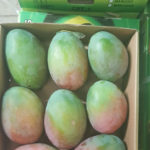 Kenya has around sixty mango cultivars but in most farms only seven are readily available. There are two major mango varieties in the country that include apple mango and ngowe. The apple variety constitutes 50% of the mango output in the Eastern province whole ngowe leads at 49% in the Coastal area. What is remarkable about the two is that they have an origin along Kenya’s coastline. They are also some of the recommended exports by the Export Processing Zone next to Boribo. Improved, high-yielding varieties like Tommy atkins, Kent, Haden and Keitt follow suit.
Kenya has around sixty mango cultivars but in most farms only seven are readily available. There are two major mango varieties in the country that include apple mango and ngowe. The apple variety constitutes 50% of the mango output in the Eastern province whole ngowe leads at 49% in the Coastal area. What is remarkable about the two is that they have an origin along Kenya’s coastline. They are also some of the recommended exports by the Export Processing Zone next to Boribo. Improved, high-yielding varieties like Tommy atkins, Kent, Haden and Keitt follow suit.
Apple and Ngowe Mangos Growth Conditions
The main areas for the cultivation of the two local cultivars is low to mid-level elevations. The do well at average elevations of 800 meters above sea level but they also thrive in altitudes of less that 1600 meters. They require well-drained mostly sandy soils and can thrive with little rainfall. The weather patterns that suit their grow range from hot to humid. Perhaps this is why the Coast and Eastern provide the best conditions in the country.
Apple and Ngowe Mangos Value Chain
The differences in the value chain preference depend by the market. For instance, apple mangos are popular in Nairobi, where farmers dispatch their harvests. For processing and raw consumption, Mombasa, in the Coast is the main market for ngowe. The factory delivery of both types for processing prevents at least 10 to 31 percent of the total 60 percent of traditional losses. The other small percentage is suitable for export.
In Nairobi’s Farmer’s Market and Eastleigh, the two types represent an overwhelming presence. They are followed by other traditional types especially peach mangos. The specific county that serves Nairobi for apple and ngowe mangoes is Makueni. Other counties like Embu, Meru and Kitui dispatch the other traditional types.
Apple mango accounts for 39% of all exports from Kenya, using government statistics of 2012. This fluctuates yearly due to the rise of improved varieties including Haden and Van Dyke. Ngowe, on the other hand, represents 17% of total exports of the fruits from the country.
There are new pressing plants in key regions of mango production such as Hola in Tana River along the coast. There is still a 40% deficit in processing potential because many farmers delay their fruit harvests or prefer table fruit exports. Still, the juice industry from all mango varieties has improved in recent years. In Eastern, the main processor is strategically situated next to Miritini EPZ near Machakos and deals in concentrates and table fruits. There are also private industries that use these mango types for value addition.
Transportation
The transportation mode for these Kenya mango varieties is usually via company or leased trucks. The most common are three-ton capacity vehicles while the rest are thirty-ton capacity ones. SMEs usually take responsibility for the total cost of transportation. In other areas like the Coast, farming societies enjoin to pay at least KSH 35,000 ($350), an ever-changing value, for a twenty-ton truck to transport their mangoes from Hola to Mombasa.
Crates, jute bags, sacks or even bulk are some of the main packing methods. For export purposes, apple and ngowe mangos attract custom wrapping in appropriate pellets that conserve the moisture levels of the produce over the lengthy journey ahead.
Export
For the export of ngowe and apple mangoes, SMEs rely on their produce agents to guide through harvesting and post-harvesting processing. This is in order to enforce the stringent requirements for EU and other makets. They improve the value chain because they maximize on the best fruits just at the right time of maturity, which reduces both farm losses and overseas rejections.
After shipment to the coastal city of Mombasa for shipping, the Kenya Plant Health Inspectorate Services (KePHIS) and other authorities check for minimum residual levels (MRLs). The exporters also recheck their consignments for any surface journey damage. They can expect at least 1% of losses or none depending on the state of packing. The main markets for these varieties outside the EU include the Kingdom of Saudi Arabia and the United Arab Emirates.
Thus, despite yielding about 200 pieces from every tree unlike their improved types like Haden, Keitt and Tommy Atkins that produce up to 1200 pieces, ngowe and apple mango still reign supreme in local and export markets.

